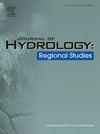Projection of glacier changes over the Laohugou Glacier No. 12, Northeast Tibetan Plateau, China from 2020 to 2100
IF 4.7
2区 地球科学
Q1 WATER RESOURCES
引用次数: 0
Abstract
Study region
Laohugou Glacier No. 12 in the Qilian Mountains, northeast Tibetan Plateau.
Study focus
Alpine glacier meltwater from the Qilian Mountains (QMs), northeast Tibetan Plateau, is the main source of water for the surrounding arid zones. Accurately reconstructing long-term mountain glacier mass balance (MB) and projecting glacier changes under climate warming are pivotal in cryospheric scientific research. In this study, Laohugou Glacier No. 12 (LHG12), in the western QMs, was selected as a study area. Based on the Coupled Model Intercomparison Project (CMIP6) models, the degree-day and glacier retreat models were used to predict the glacier changes under three scenarios for 2020–2100.
New hydrological insights for the region
From 2020–2100, the annual mass loss of LHG12 simulated using CanESM5 and EC-Earth3 which perform best increased compared to the measured data in the historical period (2010–2014) (i.e., annual MB of −0.26 m w.e) by a factor of 1.04 and 1.73 under SSP1–2.6, 4.62 and 4.88 under SSP3–7.0, and 6.23 and 7.15 times under SSP5–8.5. By 2100, the ice volume and area of LHG12 simulated using CanESM5 and EC-Earth3 reduced to 0.03×109 (1.6 %) and 0.01×109 (0.4 %) m3, 1.87 and 0.75 km2 under SSP5–8.5, respectively.
求助全文
约1分钟内获得全文
求助全文
来源期刊

Journal of Hydrology-Regional Studies
Earth and Planetary Sciences-Earth and Planetary Sciences (miscellaneous)
CiteScore
6.70
自引率
8.50%
发文量
284
审稿时长
60 days
期刊介绍:
Journal of Hydrology: Regional Studies publishes original research papers enhancing the science of hydrology and aiming at region-specific problems, past and future conditions, analysis, review and solutions. The journal particularly welcomes research papers that deliver new insights into region-specific hydrological processes and responses to changing conditions, as well as contributions that incorporate interdisciplinarity and translational science.
 求助内容:
求助内容: 应助结果提醒方式:
应助结果提醒方式:


